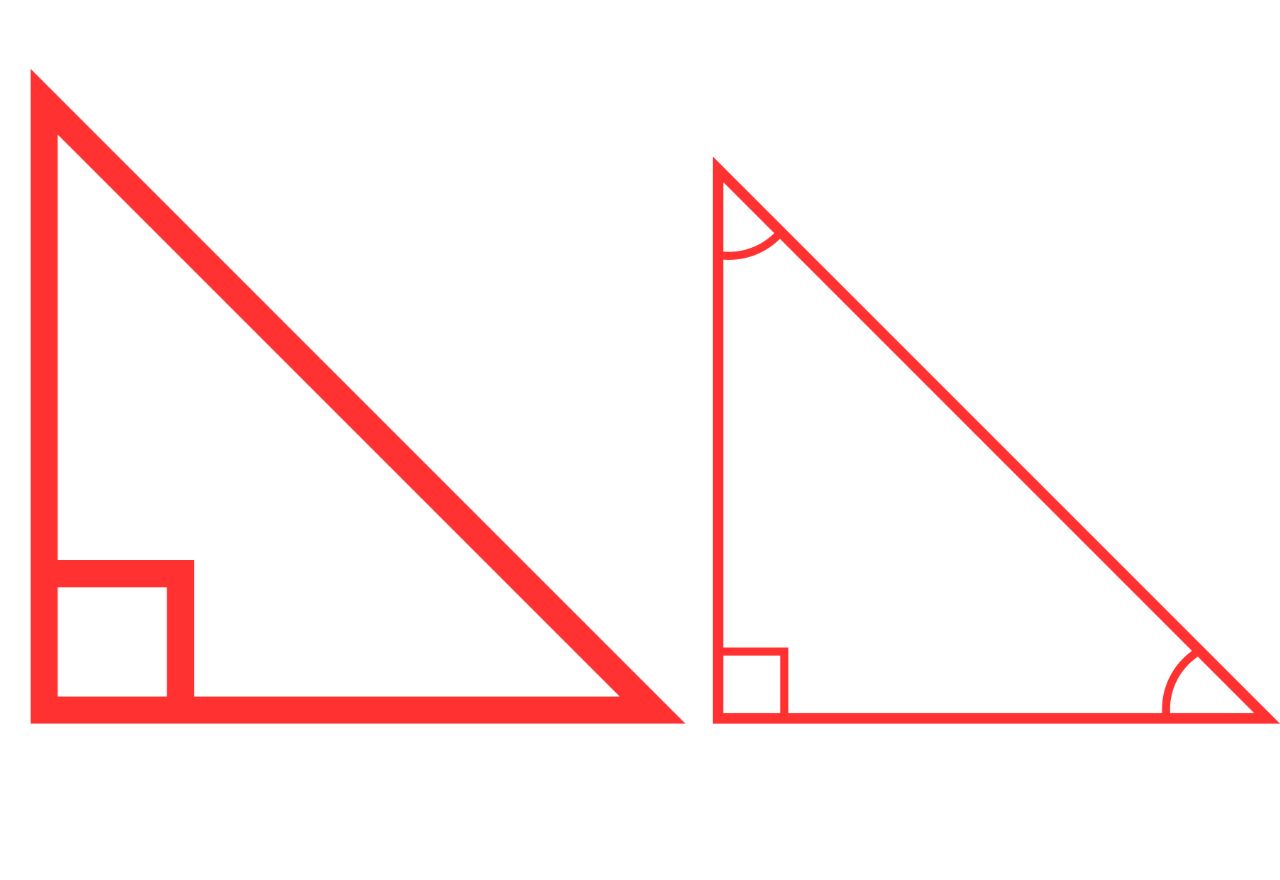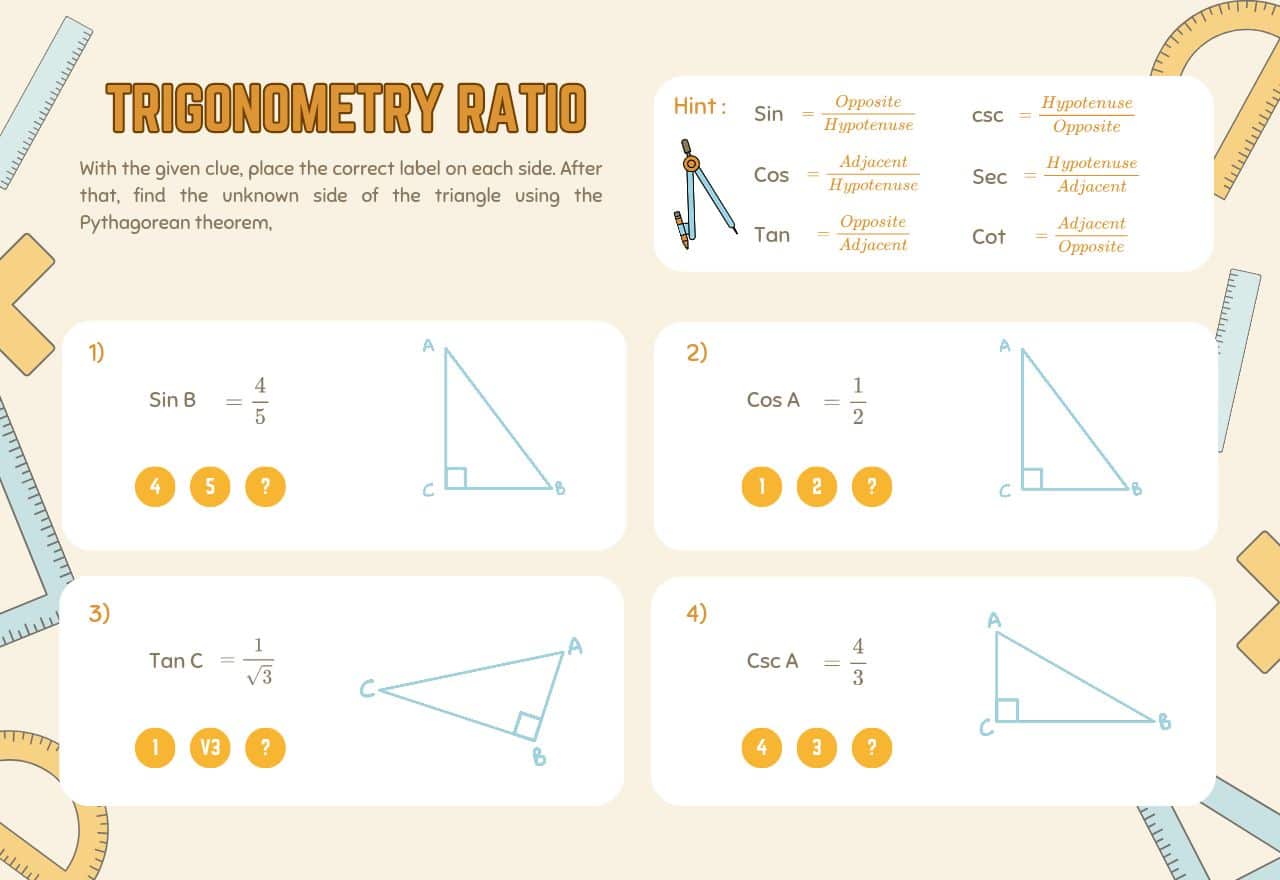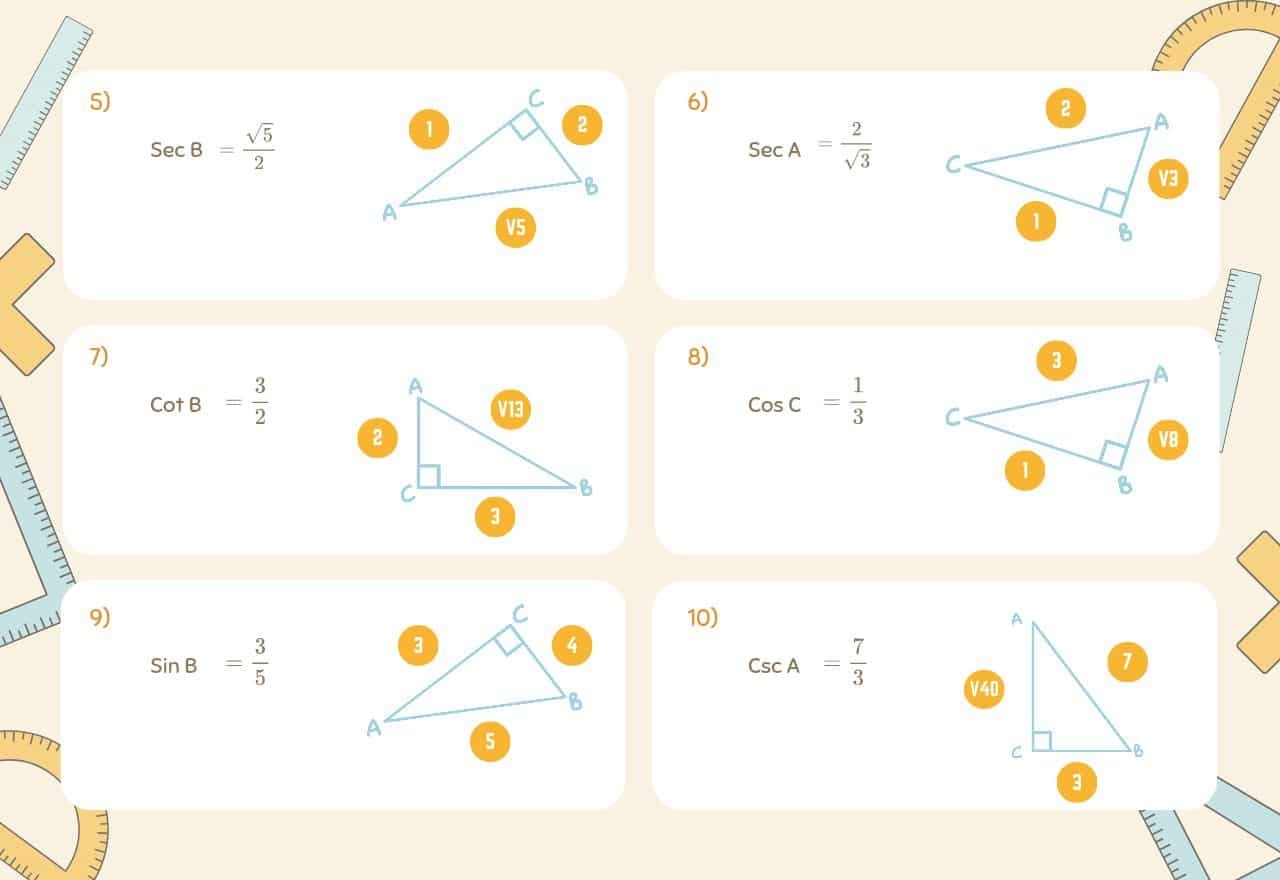1. Introduction to Trigonometry
What is Trigonometry?
Trigonometry is a branch of mathematics that deals with the relationships between the sides and angles of triangles. It explores how the lengths of sides and the measures of angles in triangles are related
supremetutorials

2. Basic Concepts of Trigonometry
Trigonometry is a branch of mathematics that deals with the study of relationships between the angles and sides of triangles. Here are some basic concepts of trigonometry:
- Angles: Angles are measured in degrees (°) or radians (rad). One complete revolution is equal to 360∘ or 2π radians.
- Right Triangle: A right triangle has one angle measuring 90∘. The side opposite the right angle is called the hypotenuse, while the other two sides are called the adjacent and opposite sides.

- Trigonometric Ratios: In a right triangle, there are three primary trigonometric ratios:
- Sine (sin): sin(θ)=Opposite/Hypotenuse
- sin(θ)=Hypotenuse/Opposite
- Cosine (cos): cos(θ)=Adjacent/Hypotenuse
- cos(θ)=Hypotenuse/Adjacent
- Tangent (tan): tan(θ)=Opposite/Adjacent
- tan(θ)=Adjacent/Opposite
- Pythagorean Identity: In a right triangle, the Pythagorean theorem states that the square of the length of the hypotenuse (c) is equal to the sum of the squares of the lengths of the other two sides (a and b):
- c2=a2+b2
- Unit Circle: The unit circle is a circle with a radius of 1 unit centered at the origin in the coordinate plane. It is used to define trigonometric functions for all real numbers.
- Trigonometric Functions: Apart from sine, cosine, and tangent, there are three reciprocal trigonometric functions:
- Cosecant (csc): cosec(θ)=1/sin(θ)
- cosec(θ)=1/sin(θ)
- Secant (sec): sec(θ)=1/cos(θ)
- sec(θ)=1/cos(θ)
- Cotangent (cot): cot(θ)=1/tan(θ)
- cot(θ)=1/tan(θ)
- Periodicity: Trigonometric functions are periodic, which means they repeat their values at regular intervals. For example, sine and cosine functions have a period of 2π radians.
These are fundamental concepts in trigonometry that form the basis for more advanced topics such as trigonometric equations, identities, and applications in geometry and physics.
Trigonometric Ratios (Sine, Cosine, Tangent)

To find sine (sin), cosine (cos), tangent (tan), and other trigonometric ratio angles without a calculator, you can use various techniques based on geometric relationships and trigonometric properties. Here are some methods:

- Special Triangles:
- Use special right triangles like the 30-60-90 triangle and the 45-45-90 triangle, which have well-defined trigonometric ratios for their angles.
- In a 30-60-90 triangle, the sides are in the ratio 1:√3:2, and the trigonometric ratios for the angles are sin 30° = 1/2, cos 30° = √3/2, sin 45° = cos 45° = 1/√2, and tan 45° = 1.
- In a 45-45-90 triangle, the sides are in the ratio 1:1:√2, and the trigonometric ratios for the angles are sin 45° = cos 45° = 1/√2 and tan 45° = 1.

- Trigonometric Identities:
- Use trigonometric identities such as the Pythagorean identity (sin² θ + cos² θ = 1) to relate sine, cosine, and tangent.
- For example, if you know sin θ and cos θ, you can find tan θ using the identity tan θ = sin θ / cos θ.
- Unit Circle:
- Use the unit circle, which is a circle with a radius of 1 centered at the origin of a coordinate plane.
- The x-coordinate of a point on the unit circle represents cos θ, and the y-coordinate represents sin θ.
- For example, at θ = 30° (π/6 radians), the coordinates are (cos 30°, sin 30°) = (√3/2, 1/2).
- Geometric Constructions:
- Use geometric constructions to create right triangles with known ratios.
- For example, if you know the side lengths of a right triangle, you can use geometric constructions to determine the trigonometric ratios and angles.
- Trigonometric Tables:
- Refer to trigonometric tables that provide values of trigonometric ratios for specific angles.
- These tables are precomputed and can be used to look up the ratios for common angles.

Trigonometric Ratios & Important Angles
Trigonometric Ratios | Angle | Value |
Sine θ | 0,30,45,60,90 | 0,1/2,1/√2,√3/2,1 |
Cosine θ | 0,30,45,60,90 | 1,√3/2,1/√2,1/2,0 |
Tangent θ | 0,30,45,60,90 | 0,1/√3,1,√3,∞ |
Cotangent θ | 0,30,45,60,90 | ∞,√3,1,1/√3,0 |
Secant θ | 0,30,45,60,90 | 1,2/√3,√2,2,∞ |
Cosecant θ | 0,30,45,60,90 | ∞,2,√2,2/√3,1 |
Sine Ratio | θ | Sin θ = tan θ/sec θ |
Cosine Ratio | θ | Cos θ = sin θ/tan θ |
Secant Ratio | θ | Sec θ = tan θ/sin θ |
Cosecant Ratio | θ | Cosec θ = sec θ/tan θ |
Tangent Ratio | θ | Tan θ = sin θ/cos θ |

Now, the formulas for other trigonometry ratios are:
Cot θ = 1/tan θ = Adjacent side/ Side opposite = AB/BC
Sec θ = 1/Cos θ = Hypotenuse / Adjacent side = AC / AB
Cosec θ = 1/Sin θ = Hypotenuse / Side opposite = AC / BC
The other side of representation of trigonometric values formulas are:
Tan θ = sin θ/cos θ
Cot θ = cos θ/sin θ
Sin θ = tan θ/sec θ
Cos θ = sin θ/tan θ
Sec θ = tan θ/sin θ
Cosec θ = sec θ/tan θ

Unit Circle and Trigonometric Functions
The Unit Circle is a circle with a radius of 1 unit, centered at the origin (0, 0) in a Cartesian coordinate system. It plays a crucial role in trigonometry as it helps define trigonometric functions for any angle in the coordinate plane.
Trigonometric functions, such as sine (sin), cosine (cos), tangent (tan), cosecant (csc), secant (sec), and cotangent (cot), are mathematical functions that relate the angles of a right triangle to the ratios of its sides. These functions can also be extended to any angle in the Unit Circle.
- Sine (sin): In a right triangle, sin(theta) is defined as the ratio of the length of the side opposite the angle theta to the hypotenuse.
- Cosine (cos): Cosine, denoted as cos(theta), is the ratio of the length of the adjacent side to the hypotenuse in a right triangle.
- Tangent (tan): Tan(theta) is the ratio of the length of the side opposite the angle theta to the side adjacent to it in a right triangle.
- Cosecant (cosec): Cosecant, represented as cosec(theta), is the reciprocal of sine, i.e., cosec(theta) = 1/sin(theta).
- Secant (sec): Secant (sec(theta)) is the reciprocal of cosine, given by sec(theta) = 1/cos(theta).
- Cotangent (cot): Cotangent, denoted as cot(theta), is the reciprocal of tangent, where cot(theta) = 1/tan(theta).

3. Right Triangle Trigonometry
Right Triangle Trigonometry is a fundamental concept in mathematics that deals with the relationships between the angles and sides of a right triangle. A right triangle is a triangle with one angle measuring 90 degrees, known as the right angle. The two shorter sides of the right triangle that form the right angle are called the legs, while the longest side opposite the right angle is called the hypotenuse.
The primary trigonometric ratios used in right triangle trigonometry are sine, cosine, and tangent, often abbreviated as sin, cos, and tan, respectively. These ratios are defined based on the angles of the triangle and can be calculated using the following formulas:
- Sine (sin) of an angle θ: sin(θ)=Opposite side/Hypotenuse
- Cosine (cos) of an angle θ: cos(θ)=Adjacent side/Hypotenuse
- cos(θ)=Hypotenuse/Adjacent side
- Tangent (tan) of an angle θ: tan(θ)=Opposite side/Adjacent side
- tan(θ)=Adjacent side/Opposite side
These trigonometric ratios are useful for solving various problems involving right triangles, such as finding missing sides or angles. Additionally, the reciprocal trigonometric ratios, cosecant (csc), secant (sec), and cotangent (cot), are also used in trigonometry:
- Cosecant (cosec) of an angle θ: cosec(θ)=1sin(θ) , cosec(θ)=sin(θ)1
- Secant (sec) of an angle θ: sec(θ)=1cos(θ) ,sec(θ)=cos(θ)1
- Cotangent (cot) of an angle θ: cot(θ)=1tan(θ) , cot(θ)=tan(θ)1
These ratios are reciprocals of sine, cosine, and tangent, respectively.
Applications of Right Triangle Trigonometry
Right triangle trigonometry is used in various fields such as engineering, physics, astronomy, and surveying to solve problems related to distances, angles, heights, and more. It forms the basis for understanding more advanced concepts in trigonometry and is essential for solving complex problems involving triangles and angles.
Pythagorean Theorem
Pythagorean Theorem

The Pythagorean Theorem is a fundamental concept in geometry that establishes a relationship between the sides of a right triangle. It states that in a right triangle, the square of the length of the hypotenuse (the side opposite the right angle) is equal to the sum of the squares of the lengths of the other two sides.
Mathematically, if a and b are the lengths of the legs of the right triangle, and c is the length of the hypotenuse, then the Pythagorean Theorem can be expressed as:
c2=a2+b2
Applications of The Pythagorean Theorem
This theorem has significant implications and applications across various fields, particularly in mathematics, physics, engineering, and architecture. It forms the basis for calculating distances, determining angles, and solving numerous real-world problems involving right triangles.
One notable application of the Pythagorean Theorem is in trigonometry, where it serves as a foundation for defining trigonometric ratios such as sine, cosine, and tangent. These ratios are essential in solving problems related to angles and distances in both two-dimensional and three-dimensional spaces.
Furthermore, the Pythagorean Theorem plays a crucial role in geometric constructions, providing a method to create right angles and geometrically construct squares and rectangles with precise dimensions.
SOH-CAH-TOA Rule
The SOH-CAH-TOA rule is a mnemonic device used in trigonometry to remember the relationships between the sides and angles of a right triangle. Here’s what it stands for:
- SOH: Sine = Opposite / Hypotenuse
- CAH: Cosine = Adjacent / Hypotenuse
- TOA: Tangent = Opposite / Adjacent
Trigonometric Identities
4. Trigonometric Identities
Pythagorean Identities
- sin2(x)+cos2(x)=1
- 1+tan2(x)=sec2(x)
- 1+cot2(x)=cosec2(x)
Sum and Difference Identities
- sin(x±y)=sin(x)cos(y)±cos(x)sin(y)
- cos(x±y)=cos(x)cos(y)∓sin(x)sin(y)
- tan(x±y)=1∓tan(x)tan(y)tan(x)±tan(y)
5 . Trigonometric Functions and Graphs
6. Periodicity of Trigonometric Functions
Importance and Applications of Trigonometry
- Trigonometry is vital in geometry, aiding in measurements, area calculations, and spatial analysis in fields like architecture and land surveying.
- It plays a crucial role in navigation and astronomy for position determination, distance calculations, and celestial object study.
- Engineering and physics rely on trigonometric principles for structural design, mechanical analysis, and wave behavior modeling.
- Computer graphics and animation use trigonometry extensively for creating realistic visuals, motion simulations, and 3D modeling.
- Mechanical and electrical systems benefit from trigonometry in gear calculations, motion analysis, AC circuit analysis, and signal processing.
- Surveying and cartography employ trigonometry for accurate mapping, elevation measurements, and geographic data interpretation.
- Wave phenomena analysis and signal processing utilize trigonometry in understanding interference, diffraction, resonance, and signal manipulation.
- Trigonometry serves as a powerful tool for mathematical modeling, periodic phenomena description, and complex system analysis across scientific disciplines.







Wonderful blog! I found it while surfing around on Yahoo News. Do you have any suggestions on how to get listed in Yahoo News? I’ve been trying for a while but I never seem to get there! Thanks
The next time I read a blog, I hope that it doesnt disappoint me as much as this one. I imply, I do know it was my option to read, however I really thought youd have something attention-grabbing to say. All I hear is a bunch of whining about one thing that you could possibly repair if you werent too busy in search of attention.
I have been exploring for a bit for any high quality articles or blog posts on this sort of area . Exploring in Yahoo I at last stumbled upon this website. Reading this info So i am happy to convey that I’ve an incredibly good uncanny feeling I discovered just what I needed. I most certainly will make sure to do not forget this website and give it a glance on a constant basis.
I love your blog.. very nice colors & theme. Did you create this website yourself? Plz reply back as I’m looking to create my own blog and would like to know wheere u got this from. thanks
You are my breathing in, I have few blogs and sometimes run out from brand :). “He who controls the past commands the future. He who commands the future conquers the past.” by George Orwell.
Some times its a pain in the ass to read what website owners wrote but this internet site is very user friendly! .
Hey, you used to write great, but the last several posts have been kinda boring… I miss your tremendous writings. Past several posts are just a little bit out of track! come on!
Very good written information. It will be supportive to anyone who usess it, as well as me. Keep up the good work – i will definitely read more posts.
Merely wanna say that this is handy, Thanks for taking your time to write this.